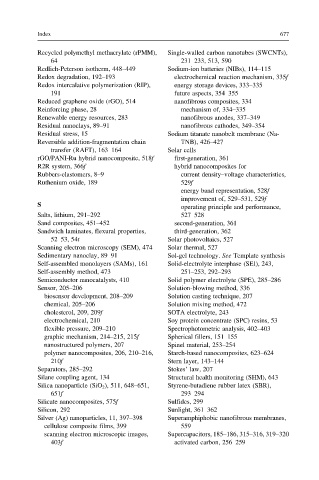Page 734 - Polymer-based Nanocomposites for Energy and Environmental Applications
P. 734
Index 677
Recycled polymethyl methacrylate (rPMM), Single-walled carbon nanotubes (SWCNTs),
64 231–233, 513, 590
Redlich-Peterson isotherm, 448–449 Sodium-ion batteries (NIBs), 114–115
Redox degradation, 192–193 electrochemical reaction mechanism, 335f
Redox intercalative polymerization (RIP), energy storage devices, 333–335
191 future aspects, 354–355
Reduced graphene oxide (rGO), 514 nanofibrous composites, 334
Reinforcing phase, 28 mechanism of, 334–335
Renewable energy resources, 283 nanofibrous anodes, 337–349
Residual nanoclays, 89–91 nanofibrous cathodes, 349–354
Residual stress, 15 Sodium titanate nanobelt membrane (Na-
Reversible addition-fragmentation chain TNB), 426–427
transfer (RAFT), 163–164 Solar cells
rGO/PANI-Ru hybrid nanocomposite, 518f first-generation, 361
R2R system, 366f hybrid nanocomposites for
Rubbers-elastomers, 8–9 current density–voltage characteristics,
Ruthenium oxide, 189 529f
energy band representation, 528f
improvement of, 529–531, 529f
S operating principle and performance,
Salts, lithium, 291–292 527–528
Sand composites, 451–452 second-generation, 361
Sandwich laminates, flexural properties, third-generation, 362
52–53, 54t Solar photovoltaics, 527
Scanning electron microscopy (SEM), 474 Solar thermal, 527
Sedimentary nanoclay, 89–91 Sol-gel technology. See Template synthesis
Self-assembled monolayers (SAMs), 161 Solid-electrolyte interphase (SEI), 243,
Self-assembly method, 473 251–253, 292–293
Semiconductor nanocatalysts, 410 Solid polymer electrolyte (SPE), 285–286
Sensor, 205–206 Solution-blowing method, 336
biosensor development, 208–209 Solution casting technique, 207
chemical, 205–206 Solution mixing method, 472
cholesterol, 209, 209f SOTA electrolyte, 243
electrochemical, 210 Soy protein concentrate (SPC) resins, 53
flexible pressure, 209–210 Spectrophotometric analysis, 402–403
graphic mechanism, 214–215, 215f Spherical fillers, 151–155
nanostructured polymers, 207 Spinel material, 253–254
polymer nanocomposites, 206, 210–216, Starch-based nanocomposites, 623–624
210f Stern layer, 143–144
Separators, 285–292 Stokes’ law, 207
Silane coupling agent, 134 Structural health monitoring (SHM), 643
Silica nanoparticle (SiO 2 ), 511, 648–651, Styrene-butadiene rubber latex (SBR),
651f 293–294
Silicate nanocomposites, 575f Sulfides, 299
Silicon, 292 Sunlight, 361–362
Silver (Ag) nanoparticles, 11, 397–398 Superamphiphobic nanofibrous membranes,
cellulose composite films, 399 559
scanning electron microscopic images, Supercapacitors, 185–186, 315–316, 319–320
403f activated carbon, 256–259

